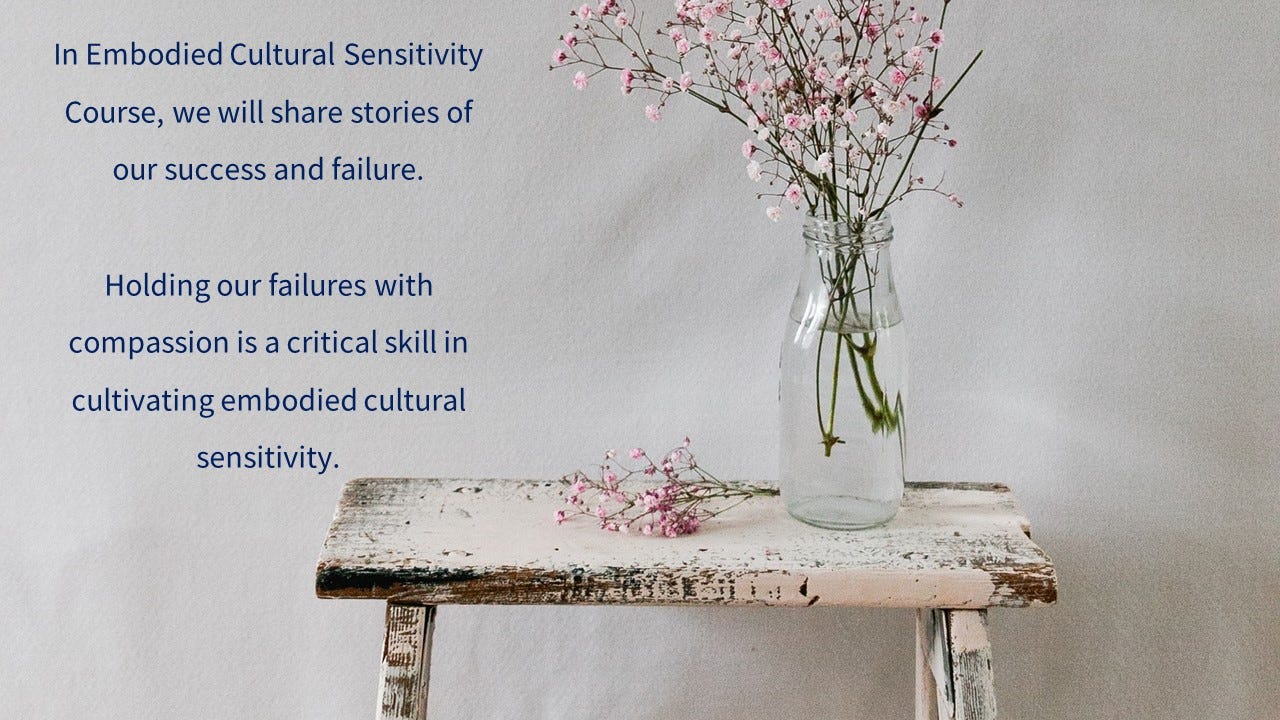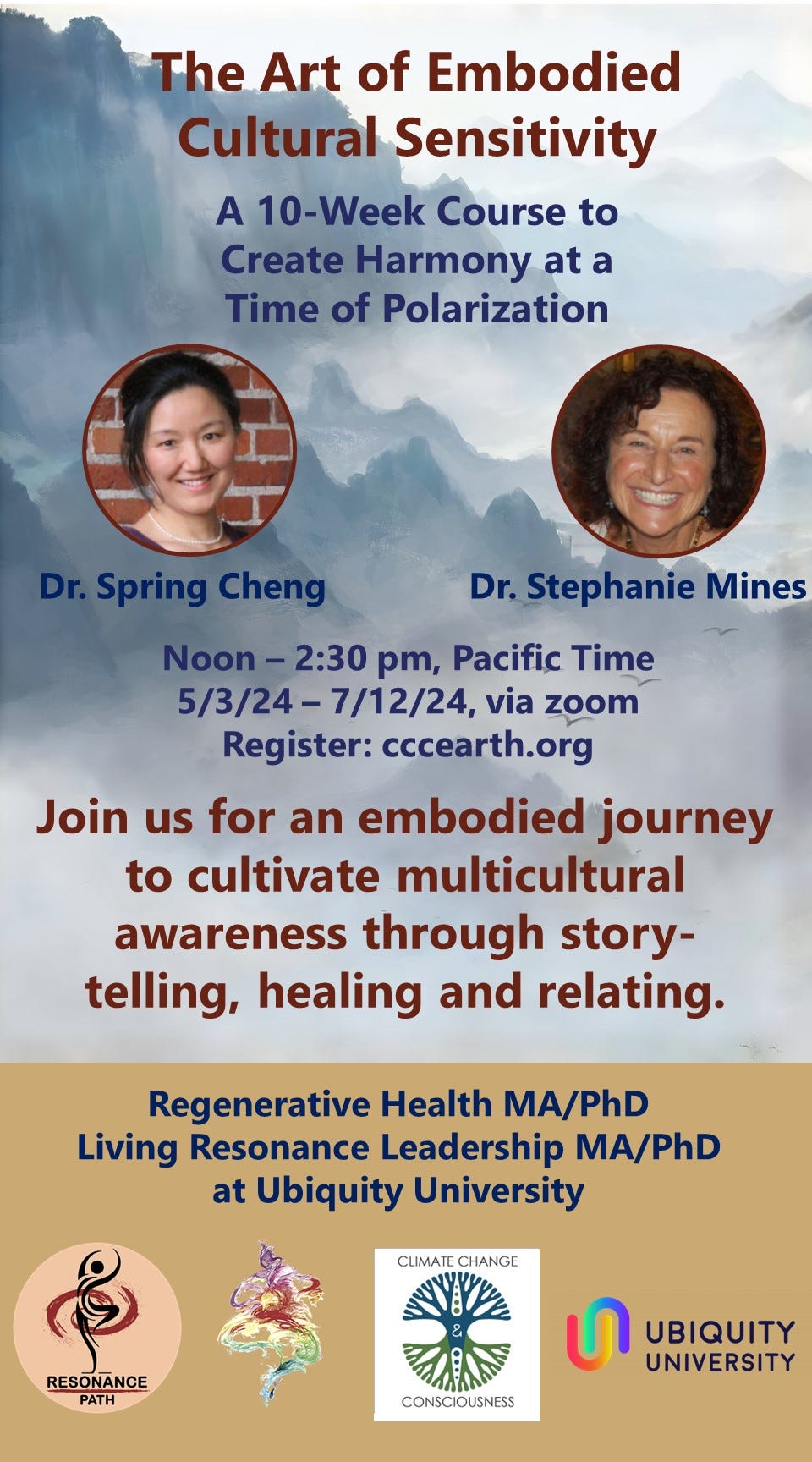In the above video, my colleague Dr. Stephanie Mines tells a moving story of how she responded with spaciousness to a justifiable anger expressed by someone from a marginalized group she worked with.
I feel honored to interview Stephanie on this issue. In my own journey of transforming my rage due to systemic injustice, I owe gratitude to many people from privileged groups who have humbly received my anger, affirmed me and helped me heal and transform rage into creativity. (For my story, please read Transforming Rage into Sacred Songs)
At the same time, I also had many not-so-productive experiences. When facing my anger, sometime people from privileged groups got confused, collapsed into guilt, became defensive, turned their back or even shouted back at me. Those situations were painful for both sides. These experiences furthered alienation and separation.
I would like to highlight several things I observed in Stephanie’s story.
First, Stephanie’s response to justifiable anger is spacious and wholesome, and it invites unity rather than being dictated by trauma.
Facing anger from anyone in any circumstance can trigger our own insecurity or defensiveness. Usually, the trigger inside of us is a doorway to our unhealed trauma. In this video, Stephanie acknowledged that part of her was triggered by the person’s remarks. However, she had been extensively investigating and healing her trauma for decades. As a result, her response to this person was no longer dictated by her history of trauma.
Second, it is crucial to do trauma healing through a mind-body integrated approach.
Stephanie is a skilled healer and neuroscientist. She specialized in the TARA approach, a synthesis between modern science and Jin Shin, an ancient Japanese healing art. Because of the holistic and integrated nature of the work Stephanie does, she was able to respond to the person SOFTLY, without the need to defend or even protect herself. Nor did she collapse under overwhelming guilt. She was secure in her own self. Therefore, she affirmed that person’s strong assertions, and expressed with integrity that instead of “take, take, take like what white people always do,” she would honor reciprocity in this relationship.
I want to emphasize that in the interview, Stephanie said that this had to be a whole-bodied, somatic response. It would have been no use if she simply said these things without feeling it and meaning it. This is an attunement between two nervous systems. Like Stephanie said, if she harbored any defensiveness, the person she interacted with would detect it.
Third, Stephanie made a clear distinction between what is personal and what is collective.
Stephanie acknowledged that the collective group that she was part of has committed something unjust and imbalanced, while staying true to who she is and what she stands for. This is a refined skill on a subtle, energetic level, a result of persistent practice and somatic tracking.
In moments like this, our individual selves are called to witness or even interact with big currents in the collective space as a result of historic events such as war and genocide. It is important we do not put up a blinder and turn away from them. At the same time, it’s also important that we are not subsumed by these currents.
Many people living in individualistic cultures are not practiced in making this distinction. My experience is that often when a member from a marginalized group expresses justifiable anger due to systemic injustice, often people from privileged group take it as a personal attack, which can lead to defensiveness, isolation or counterattack.
My native Chinese culture actively weaves into the cultural fabric a contextually sensitive switching back and forth between speaking as an individual I or as a collective “Zan,” different from “we” or “us”, rather a temporary spokesperson for a family, group or village. It requires cultivated awareness to differentiate and respond accordingly.
The collective sometimes needs to speak through an individual person, especially the part of collective experience that has not been brought into public awareness yet. Of course, in these cases, that part of the collective experience will be interpreted through the lens shaped by the individual’s worldview, life experience and disposition. It takes communication skills, somatic tracking and self-awareness to both speak and listen effectively in conversations where systemic imbalance is a key component.
Fourth, living our own purpose with joy and commitment leads to a personal integrity that can hold the anger.
The fourth point of Stephanie’s story more came from my observation of Stephanie as one of my closest colleagues. Stephanie has an unwavering commitment to her life’s purpose, working towards and advocating for a regenerative health paradigm, and embodying the kind of leadership that she believes in to respond to climate change, war and the many other crises we are facing.
Stephanie is living her purpose with feisty joy. She is the most energetic 80-year-old lady I have ever met, teaching courses and seeing clients while being active every day swimming, biking and doing yoga. She is also a prolific writer and poet, active in publishing her work. Stephanie’s example illustrates how thriving and keeping the flow of our own life energy strong is a critical component to maintain our personal integrity when engaging in difficult conversations like this.
Successes and Failures
In this video, Stephanie tells the story of one example where she was able to gracefully respond to a difficult situation with spaciousness. In talking with her, I don’t get the sense that Stephanie meant to say that she was above-and-beyond trauma response. We are simply here to tell a story of a success that is worthy of celebration.
Even between Stephanie and I, we constantly experience small frictions as a result of the clashes between the cultural systems that we inherited from our lineages. We fail, rub each other in the wrong way, or get caught in our own trauma responses all the time.
However, we have made a pact with each other that we will support, hold and stand by each other, even when we are failing, or falling short of our own standard, or hurting each other, as long as we are willing to look back and reflect on ourselves with honesty and authenticity. When we do that, we find more and more spaciousness to hold the clashes we have had, sometimes with even a smile.
In the upcoming course Art of Embodied Cultural Sensitivity, we are not only sharing with you our stories of success but also stories of our “failures”, which are equally valuable. In fact, to hold our own “failures” with compassion is another critical skill we will practice together.
Through our own trials and errors, we have carve out a path and we want to invite you to come with us. You don’t have to practice for twenty years to get to where Stephanie has illustrated in the video. There are small steps to be taken in this direction, each of which yields tangible differences in one’s ability to hold spaciousness in difficult conversations.
Coming next: A sense of belonging anchored in the universal field of consciousness or life energy.
For both Stephanie and I, we source our work from lineages of East Asian medicine, which sees the human body as an embodied vehicle of qi, the universal field of consciousness or life energy, which animates all living beings. Stephanie’s source is from Jin Shin, a Japanese healing art. Mine is from Chinese medicine. We also both infuse the ancient arts with our individual innovations. This universal field of energy is where we anchor our sense of belonging and receive nourishment.
Anchoring our being in this universal field of energy provides the foundation to our resilience and creativity when we are facing complex and challenging situations.
For more on this topic, please stay tuned for the next video: Sense of belonging anchored in the universal field of consciousness.
All the things covered in this post will be elements we will share and practice in the upcoming course: The Art of Embodied Cultural Sensitivity.
Join us in the free pre-course at noon pacific time on Apr 19!






